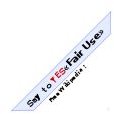Example of Fair Use Can Protect Teachers and Bloggers
How to Define Fair Use
Locating an example of fair use is difficult without initially understanding fair use guidelines in the first place. The University of Texas(1) reveals that fair use is embattled legal territory that defies a clear definition, especially in light of the uncharted territory that cyberspace and social networking now present. Even so, the law that governs its application is the U.S. Code Title 17, Chapter 1, § 107(2).
What is Fair Use: The Fine Print
According to the letter of the law, the doctrine of fair use applies to copyrighted materials. It involves reproduction of such items by various means, including visual and auditory. What sets apart fair use from copyright infringement is the specific use that the person makes of the item. Examples of fair use that are expressly permitted include:
- Commentary and the use of the item for news reporting
- Criticism
- Education within a classroom setting
- Research within the confines of academia and without
Even so, fair use copyright regulations also take into account the likely outcome that the application of the material has on the copyright owner. Thus, it is theoretically possible to claim fair use but still get into legal trouble, depending on secondary factors, including but not limited to:
- Use of copyrighted materials within ventures expressly undertaken for financial gain
- Use of excessive portions of the material in question
- Potentially adverse effects the use of the material by a third party is likely to have on the market value of the copyrighted material
Example of Fair Use that Fails to Pass the Smell Test
In this example the copyrighted material is a news article – created for hire – by a freelance writer. Written with proper SEO practices observed and posted online, it does well and results in copious hits to the website. A blogger takes note of this successful article and posts it – in its entirety – on a personal blog; in order to apply the fair use doctrine, the blogger adds a brief commentary of “I totally agree” to his page.
Understanding the Problems that Lead to an Unfair Use Determination
This example highlights the mistaken application of the fair use doctrine within a social media setting. The blogger erred in two crucial aspects:
- While it is immaterial if the posted article would lead to financial gain for the blogger, it is noteworthy that copying a work in its entirety – even when accompanied by a brief commentary – falls outside the scope of fair use.
- Posting the article in a secondary venue effectively leads to a cannibalizing of the work on itself. In effect, the SEO practices employed by the writer now draw readers away from the original article, which is likely posted for profit, and send them to the secondary posting, which is of no profit to the original writer but might actually cut into the author’s royalty revenues.
This example highlights why the claim of fair use does not apply in this case. It appropriates an entire work and leads to the fiscal detriment of the copyright owner.
Why is Fair Use Important?
It is evident that fair use is of the utmost importance to allow an open dialog and to capitalize on learning and data without robbing the owner of the copyrights. The University of Texas(3) proposes an acid test to help students and faculty when seeking to understand classroom guidelines, fair use, copyright regulations and the integration of data in the teaching process. It is noteworthy that this approach also works well for the blogger or social media aficionado.
The test is as follows:
- If copyrighted material will be used within a nonprofit, educational or personal setting, it is fair game. Within a commercial setting, there is good reason to assume that a legal challenge could arise. Somewhat in the grey zone but generally considered fair use are news reporting, criticism and commentary as well as parody.
- Selective use of small quantities of copyrighted materials is fair use, whereas the use of larger amounts could lead to a copyright violation. One mitigating factor is the clear delineation of the use within an educational or nonprofit setting.
- Financial impact is another litmus test. If the use of the copyrighted material leads to financial detriment for the owner, it becomes unfair use. A good example is the fair use violation in Princeton University Press v. Michigan Document Services, wherein a photocopying company failed to fiscally reimburse a school for the use of teaching materials it copied for its own purposes.
If you are still confused about what truly does constitute an example of fair use, remember that in case of a doubt it is always best to simply ask the copyright owner for permission to use the material. Failing that, paraphrasing the material and crediting the source is another work-around for the blogger, social media aficionado and student who does not want to get into hot water over a copyright infringement or unfair use practices.
Sources
- https://www.utsystem.edu/ogc/intellectualproperty/copypol2.htm
- https://www.law.cornell.edu/uscode/html/uscode17/usc_sec_17_00000107—-000-.html
- https://www.utsystem.edu/ogc/intellectualproperty/copypol2.htm#test
Photo Credit: “Fair Use” by Pausanias/Wikimedia Commons at https://commons.wikimedia.org/wiki/File:YES_to_Fair_Use.svg
